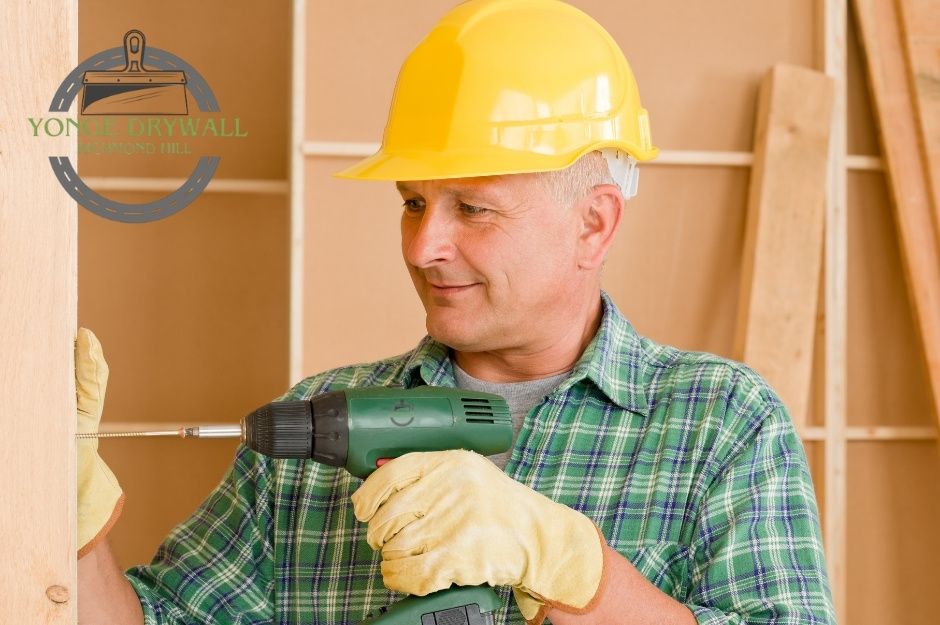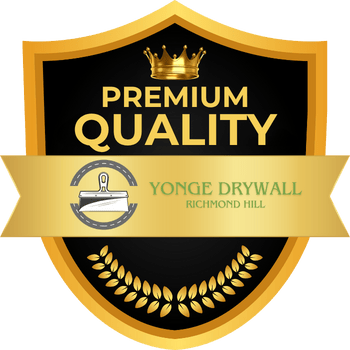Drywall Repair Caledon
Top-Quality Drywall Repair Service Company in Caledon, Ontario

Drywall issues can transform your Caledon home from a comfortable retreat into a source of constant frustration. Professional drywall repair contractors at Yonge Drywall Richmond Hill in Caledon, Ontario specialize in comprehensive solutions that address everything from minor hole patching to complete ceiling panel replacement and advanced soundproofing installations.
Whether you're dealing with unsightly ceiling cracks, outdated popcorn textures, or water damage from Ontario's harsh weather conditions, these problems rarely resolve themselves and often worsen over time.
With Caledon spanning 688 km² as the largest municipality by area in the Greater Toronto Area, homeowners across communities from Bolton (population 26,795) to rural hamlets like Belfountain and Alton face unique drywall challenges based on their property's age and location.
Understanding your repair options and the expertise available locally helps you make informed decisions about your home's interior restoration. Whether you're in the urbanizing southern areas bordering Brampton, the historic villages established in the 1800s, or the rural service centres like Caledon East and Mayfield West, professional contractors understand the specific needs of Caledon's diverse housing stock. From addressing structural concerns like sagging ceilings to enhancing your living space with professional finishing techniques, the right approach depends on your specific needs and the extent of damage you're facing.

Yonge Drywall Richmond Hill (HP)

Comprehensive Drywall Repair Solutions in Caledon, Ontario
Professional drywall repair services address structural issues like ceiling cracks and water damage, while specialized techniques handle popcorn ceiling removal and precise hole patching for seamless wall restoration.
Ceiling Crack and Panel Replacement
Ceiling cracks develop from settling foundations, temperature fluctuations, and structural movement. In Caledon's older communities like Belfountain (established in 1869) and Caledon Village, historic homes often experience settling that creates ceiling cracks requiring professional assessment. Small hairline cracks require mesh tape and joint compound application.
Larger cracks need complete panel replacement to prevent recurring damage. Professional contractors remove damaged sections and install matching drywall panels.
Common ceiling issues include:
- Settlement cracks along joints
- Nail pops from loose fasteners
- Sagging panels from moisture exposure
- Foundation settling common in Caledon's older townships of Albion and former Chinguacousy areas
Panel replacement involves cutting precise measurements and securing new drywall with appropriate screws. The seams receive paper tape and multiple compound coats.
Texture matching ensures seamless integration with existing ceiling surfaces. Prime and paint application completes the repair process.
Popcorn Ceiling Removal
Popcorn ceiling removal requires specialized equipment and safety protocols. Many older popcorn textures contain asbestos materials that need professional testing. Homes built in Caledon during the 1970s—when the Town of Caledon was officially formed in 1974 from villages including Bolton and Caledon East—often contain popcorn ceilings that require asbestos testing before removal.
The removal process begins with plastic sheeting protection for floors and furniture. Water spray application softens the texture for scraping.
Removal steps include:
- Asbestos testing when applicable
- Room preparation and containment
- Texture scraping with specialized tools
- Surface cleaning and smoothing
After texture removal, contractors sand rough areas and apply primer coats. New smooth finish or alternative textures can replace the original popcorn surface.
Professional removal prevents airborne particles and ensures complete texture elimination. The ceiling receives final sanding before painting preparation.
Expert Hole and Sagging Patching
Hole patching techniques vary based on damage size and wall location. Small nail holes require simple spackling compound application and sanding.
Medium holes need mesh patches or backing material for structural support. Large holes require drywall piece installation with proper fastening.
Patching materials include:
- Spackling compound for minor holes
- Self-adhesive mesh patches
- Backing boards for large repairs
Sagging drywall results from moisture damage or inadequate fastening. In Bolton, Caledon's primary administrative and commercial centre, newer construction developments may experience drywall issues from rapid building during population growth, while rural properties near the Credit River (which flows through Belfountain) face moisture-related sagging from elevated humidity levels. Contractors add screws at proper intervals and replace severely damaged sections.
Multiple compound coats create smooth surfaces that blend with surrounding walls. Sanding between coats ensures professional-grade finish quality.
Texture matching and paint application complete the repair process. Proper techniques make patches virtually invisible after completion.
Water Damage and Stain Remediation
Water damage creates brown stains, soft drywall areas, and potential mold growth. Immediate assessment determines repair scope and safety requirements. Caledon properties located in communities like Cataract, Alton, and Terra Cotta near waterways require particular attention to water damage prevention, while homes in the southern urbanizing areas bordering Brampton may experience plumbing-related water damage common to newer construction.
Damaged sections require complete removal to prevent mold development. Contractors cut out affected areas and inspect underlying insulation.
Water damage indicators:
- Brown or yellow staining
- Soft or crumbling drywall
- Musty odors indicating mold
- Moisture infiltration common in Caledon's rural properties with well water systems
New drywall installation includes moisture barrier application when needed. Proper ventilation prevents future water damage in repaired areas.
Stain-blocking primer prevents bleed-through on remaining surfaces. Multiple primer coats ensure complete stain coverage before final painting.
Professional water damage repair includes source identification and correction. Complete remediation prevents recurring moisture problems and structural damage.
Professional Drywall Installation Services
Professional drywall installation in Caledon encompasses specialized applications designed for specific performance requirements. Soundproofing solutions and moisture-resistant materials address unique building needs that standard drywall cannot meet. With Highway 10, Highway 410, and major routes like Airport Road (Peel Road 7) carrying significant traffic through Caledon to the Georgian Triangle, homes near these corridors benefit from soundproof drywall installation to reduce road noise.
Soundproof Drywall Installation
Soundproof drywall installation requires specific materials and techniques to reduce noise transmission between rooms. The process involves using specialized acoustic drywall panels that contain sound-dampening layers or installing multiple layers of standard drywall with sound-dampening compounds.
Professional installers measure the space and determine the appropriate thickness and type of soundproof drywall. Mass-loaded vinyl barriers are often installed behind the drywall for additional sound reduction. Properties along Highway 50 in Bolton, where GO Transit and Brampton Transit Route 41 operate, particularly benefit from soundproofing installations to minimize traffic and transit noise.
The installation process includes:
- Proper stud spacing measurement
- Acoustic sealant application at joints
- Specialized screws and fasteners
- Green glue or similar sound-dampening compounds between layers
Soundproof drywall typically adds 2-4 inches to wall thickness. This affects electrical outlet placement and door frame adjustments. Multi-family developments in Mayfield West and industrial properties near Sandhill and Tullamore commercial centres frequently require soundproof installations to meet commercial building codes.
Moisture-Resistant and Specialty Drywall Options
Moisture-resistant drywall installation is essential for bathrooms, basements, and areas prone to humidity. Green board and cement board are common moisture-resistant options that prevent mold growth and structural damage. Caledon's rural properties, which make up the majority of the town's 696.04 km² area, often have basement moisture issues requiring specialized drywall solutions, particularly in hamlets like Inglewood, Cheltenham, and Palgrave.
Purple drywall offers superior moisture resistance compared to green board. It contains moisture-resistant core materials and treated paper surfaces.
Fire-resistant drywall contains glass fibers and other additives that slow flame spread. This specialty drywall is required in certain commercial applications and residential areas near furnaces or electrical panels. Properties in Caledon's industrial centres at Sandhill, Tullamore, and Victoria require fire-resistant drywall installations to meet commercial safety standards.
Installation considerations include:
- Proper ventilation requirements
- Sealing all joints with appropriate compounds
- Using moisture-resistant screws and fasteners
- Special attention to homes built from the 1974 municipal amalgamation period requiring upgrades to modern moisture-resistance standards
Specialty drywall costs 20-30% more than standard drywall but provides long-term protection in challenging environments.
Drywall Finishing and Customization Techniques
Professional drywall finishing requires precision in mudding, taping, and sanding to create seamless surfaces. Texture matching ensures repairs blend invisibly with existing walls while surface enhancement techniques prepare drywall for final decorative treatments. Caledon's 76,581 residents (2021 census) across diverse communities from modern Bolton subdivisions to century-old farmhouses require contractors skilled in matching various historical and contemporary finishing styles.
Precise Mudding and Taping
Your drywall finishing starts with proper joint compound application over seams and fasteners. Professional technicians apply three coats of mud, progressively widening each layer to create smooth transitions.
The first coat embeds paper or mesh tape into fresh joint compound. This base layer fills the joint depression and secures the tape without air bubbles or wrinkles.
Second and third coats feather the edges wider than the previous application. Each coat requires complete drying before sanding smooth with fine-grit paper.
Critical finishing steps:
- Apply consistent pressure during mudding
- Sand between coats for uniform texture
- Prime bare joint compound before painting
- Match existing wall thickness exactly
- Account for historic plaster walls in Caledon's villages established in the 1800s when transitioning to modern drywall
Corner beads receive similar treatment with compound applied to both sides. Inside corners use paper tape folded at 90 degrees for clean lines.
Texture Matching and Surface Enhancement
Your existing wall textures require careful analysis before drywall repair work begins. Professional contractors identify texture patterns like orange peel, knockdown, or smooth finishes to ensure seamless repairs. Properties throughout Caledon's 10 former municipalities—which merged to form the current town in 1974—display varying texture styles from each era, requiring contractors familiar with decades of finishing trends across the Region of Peel.
Common texture applications:
- Orange peel: Light spray texture with fine droplets
- Knockdown: Heavy texture flattened with trowel
- Skip trowel: Hand-applied random patterns
- Heritage plaster textures: Found in historic Caledon communities like Mono Mills and Campbell's Cross
Texture matching involves recreating the exact depth, pattern, and density of surrounding surfaces. This process often requires custom mixing of joint compound consistency and specialized application tools.
Surface preparation includes thorough cleaning and primer application before texture work. Your repaired areas receive base coats that match the porosity of existing drywall surfaces. With new housing developments in southern Caledon bordering Brampton and established rural properties in the northern sections near Mono Mills, contractors must adapt techniques to match both contemporary smooth finishes and traditional textures.
Professional equipment like spray guns, rollers, and trowels recreate original textures precisely. Multiple sample areas help verify texture match before completing full repairs.
